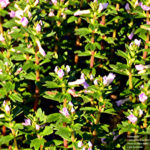Limnophila sessiliflora
Non-Native
USDA, NRCS. 2018. The PLANTS Database (http://plants.usda.gov, 28 March 2018). National Plant Data Team, Greensboro, NC 27401-4901 USA.
Illustration courtesy of University of Florida/IFAS Center for Aquatic and Invasive Plants. Used with permission.
What is Asian Marshweed?
Physical Characteristics
Leaves:
- Arranged in whorls around stem
- 0.17 – 0.5 inches long
Emerged:
- Dark green
- Sword-shaped
- Whorls of 5-8
- Edges serrated
Submerged:
- Feathery
- Opposite
Flowers:
- Small
- Stalkless
- Single flowers
- Located on top of plant
- Above water
- Petals 0.2-0.39 inches long
- Blue, lavender, pink, or violet
- Upper lip white or pink with 2 blue dots
- 3 oval lobes
- 0.16 – 0.28 inches long
- Hairy
Fruit:
- Dry seed pod
- Elliptical shaped
- 0.14 – 0.22 inches long
- Green-brown in color under water
- Dark brown in color above water
Stem:
- Up to 12 feet long
- Many inches above water and upright
Roots:
- Rooting at nodes
Where Does it Grow?
Non-Native
Asian marshweed is native to India, Ceylon, and the Philippines.
Is it Invasive?
Asian marshweed is non-native to North America and it can be an aggressive invader of ponds and other bodies of water. If colonies cover the surface of the water, then oxygen depletion and fish kills can occur. These plants should be controlled before they cover the entire surface of the pond.
This is a non-native plant that should not be grown as it is invasive and illegal to possess or transport this species in Texas. Please report sightings to the Texas Parks and Wildlife Department at (512) 389-4800.



